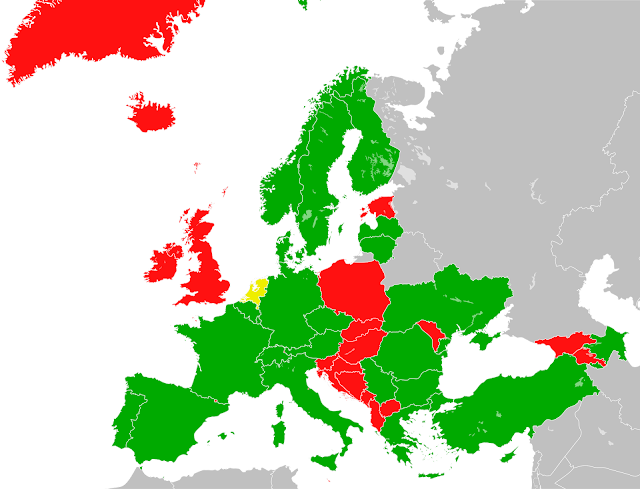 |
| European Convention for the Protection of Pet Animals. States signed and ratified in green. |
The reason why the United Kingdom did not agree is because the Convention sensibly required signatories to the convention to ban tail docking. The premier dog association The Kennel Club and other dog associations presumable lobbied Parliament and convinced the government to not ratify the convention (sign up to it) because of the ban on tail docking.
In not agreeing to this excellent document, they appear to have allowed the Governing Council of the Cat Fancy (GCCF) to continue breeding flat-faced "ultra-type" or "hyper-type" Persian cats despite the GCCF declaring they would take steps to control this (see below).
In not agreeing to this excellent document, they appear to have allowed the Governing Council of the Cat Fancy (GCCF) to continue breeding flat-faced "ultra-type" or "hyper-type" Persian cats despite the GCCF declaring they would take steps to control this (see below).
 |
| Flat-faced Persian illustrating the GCCF page on this cat breed. |
The selective breeding of the Persian cat to create a short skull and nose is referred to in a resolution of experts that is based on the convention. The resolution sets out breeding guidelines. They say that the flat face is something to be avoided in breeding. That is obvious to most people from the point of view of health issues but it is nice to see it stated at a high political level.
It is disappointing to note that the UK, a country seen as a nation of animal lovers, failed to sign up to an agreement that protects animals. People don't in general know about this fundamental failure. We have to ask whether the British really are animal lovers.
At Article 5 the convention refers to the vexed question of ethical breeding. The eurocrats have done something very good here. They have decided that sometimes breeders of purebred cats and dogs breed to extreme when over-focusing on appearance to the detriment of health.
Here is Article 5:
Any person who selects a pet animal for breeding shall be responsible for having regard to the anatomical, physiological and behavioral characteristics, which are likely to put at risk the health and welfare of either offspring or the female parent.
In short and in layperson's language: when breeding cats and other animals there should be a concern for the cat's health and behavior. Common sense. The Convention simply requires responsible breeding.
As a consequence of the convention and resolution, the GCCF agreed in a declaration (March 1995 - almost 20 years ago) that they would "take necessary measures to control the breeding of animals with genetic or phenotypic characteristics harmful to the welfare of the animals in order to prevent suffering of such animals."
You only have to see the Persians on their website today (May 2012) to conclude that the GCCF still support the breeding of extreme Persians. Can someone tell me why? Have I missed something?
Update: you can see that I first wrote this article in 2012. So, I decided to check whether anything has changed. It has not. It should be noted that this convention is not limited to EU members. It is wider than that. The UK is listed as "not signed" but it is a part of the Council of Europe member states.
Wikipedia states that the European Convention for the Protection of Pet Animals can be described as follows:
A treaty of the Council of Europe to promote the welfare of pet animals and ensure minimum standards for their treatment and protection. The treaty was signed in 1987 and became effective on 1 May 1992, after at least four countries had ratified it. Adherence to the treaty is open and not limited to member countries of the Council of Europe. As of June 2020, it has been ratified by 24 states (most recently by Spain in July 2017).
Some member states who have signed are exempt from the prohibition of tail docking as allowed by this convention. Wikipedia states that: "No country that has ratified the treaty has made any reservations regarding the other cosmetic surgeries prohibited by §10: cropping of ears, removal of vocal cords, and declawing."
It seems that tail docking is the problem area for members of this Convention. The reference to declawing is interesting because although it is commonplace in America it is simply not on the radar in Europe or the UK. And I'm referring to declawing for non-therapeutic reasons.
Interestingly, the GCCF Persian breed standard does not say that the cat's face should be flat as far as I can see and rather particularly it states that the head of the Persian should be "well-balanced". How can it be well-balanced when one side of it is entirely flat? The CFA breed standard for this cat states that the face must be flat and so I wonder why British Persian cat breeders are still reading flat-faced Persians?



No comments:
Post a Comment
Your comments are always welcome.